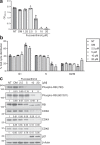Stabilization of CDK6 by ribosomal protein uS7, a target protein of the natural product fucoxanthinol
- PMID: 35681048
- PMCID: PMC9184650
- DOI: 10.1038/s42003-022-03522-6
Stabilization of CDK6 by ribosomal protein uS7, a target protein of the natural product fucoxanthinol
Abstract
Cyclins and cyclin-dependent kinases (CDKs) regulate the cell cycle, which is important for cell proliferation and development. Cyclins bind to and activate CDKs, which then drive the cell cycle. The expression of cyclins periodically changes throughout the cell cycle, while that of CDKs remains constant. To elucidate the mechanisms underlying the constant expression of CDKs, we search for compounds that alter their expression and discover that the natural product fucoxanthinol downregulates CDK2, 4, and 6 expression. We then develop a method to immobilize a compound with a hydroxyl group onto FG beads® and identify human ribosomal protein uS7 (also known as ribosomal protein S5) as the major fucoxanthinol-binding protein using the beads and mass spectrometry. The knockdown of uS7 induces G1 cell cycle arrest with the downregulation of CDK6 in colon cancer cells. CDK6, but not CDK2 or CDK4, is degraded by the depletion of uS7, and we furthermore find that uS7 directly binds to CDK6. Fucoxanthinol decreases uS7 at the protein level in colon cancer cells. By identifying the binding proteins of a natural product, the present study reveals that ribosomal protein uS7 may contribute to the constant expression of CDK6 via a direct interaction.
© 2022. The Author(s).
Conflict of interest statement
The authors declare no competing interests.
Figures






References
Publication types
MeSH terms
Substances
LinkOut - more resources
Full Text Sources
Molecular Biology Databases

